文章信息
- 姚杰, 张春雨, 赵秀海
- Yao Jie, Zhang Chunyu, Zhao Xiuhai
- 吉林蛟河阔叶红松林树种空间分布格局及其种间关联性
- Species Spatial Distribution Patterns and Species Associations in a Broad-Leaved Korean Pine Forest in Jiaohe, Jilin Province
- 林业科学, 2018, 54(8): 23-31.
- Scientia Silvae Sinicae, 2018, 54(8): 23-31.
- DOI: 10.11707/j.1001-7488.20180803
-
文章历史
- 收稿日期:2016-07-08
- 修回日期:2018-06-24
-
作者相关文章
明确影响森林群落物种空间分布的生态学过程,进而解释森林群落物种共存与多样性维持机理是生态学研究的重要目标之一(Ricklefs, 1990; Brown et al., 1995; Condit et al., 2000)。研究森林群落中个体的空间分布格局对理解植物群落构建机制具有重要意义(Wiegand et al., 2007a; 2007b; Wang et al., 2010; Luo et al., 2012),如物种间的空间分离能够阻止或减缓竞争优势物种对竞争劣势物种的竞争排除作用,有利于物种共存,促进生物多样性维持(Stoll et al., 2001)。植物体的空间分布格局是个体互作(竞争或促进作用)(Callaway et al., 1997; Bruno et al., 2003; Lortie et al., 2004)、扩散限制(Wong et al., 1970; Hubbell, 1997; 2001)、生境过滤(Harms et al., 2001; Gunatilleke et al., 2006)和Janzen-Connell假说(Janzen, 1970; Connell, 1971)等生态学过程对植物个体整个生活史综合作用的结果,因此通过恰当的分析手段研究植物个体的空间分布格局可以明确不同的生态学过程在促进物种共存和维持物种多样性中的作用。
空间点格局分析(Ripley, 1981; Stoyan et al., 1994; Diggle, 2003; Illian et al., 2008)能够量化研究区域内植物个体在不同尺度上的空间分布和种间共存格局。作用于植物群落的生态学过程具有尺度依赖性(Levin, 1992; Wiegand et al., 2004),因此,空间点格局分析应同时考虑多尺度。植物个体空间分布格局同时受到非生物环境与生物环境交互作用的影响(Getzin et al., 2008),植物个体相同的分布格局可能由不同的生态学过程导致。异质性泊松模型能够通过控制较大尺度的格局(由生境关联引起)来研究植物个体在较小尺度的空间格局(由个体与个体之间直接相互作用引起),以区分非生物环境和生物因素对植物体空间分布的影响(Wiegand et al., 2007a; 2007c)。
原始阔叶红松(Pinus koraiensis)林是我国东北温带地区典型的地带性顶级森林植物群落类型,具有很高的保护和研究价值(王蕾等, 2009;侯红亚等, 2013)。我国开展阔叶红松林种群空间格局研究已有20多年历史。阳含熙(1985)用不同的方法对长白山北坡阔叶红松林的主要树种分布格局进行了研究,此外,频次分布法(李俊清,1986)、方差均值比检验、泊松分布的X2检验及负二项分布的X2检验(孙伟中等, 1997)、相邻木结构单元法(惠刚盈, 1999; 2013;胡艳波等, 2003;徐海等,2006)、Repley’s K点格局(侯向阳等,1997)等方法在阔叶红松林种群空间格局研究中均有应用。以往的研究运用不同的分析方法定量描述阔叶红松林种群空间分布格局,且仅对群落中少数优势树种空间关联格局进行分析,较少涉及不同空间尺度下种群空间分布格局与种间关联性研究;其次,通过研究种群空间分布格局与种间关联性进而深入理解群落尺度上的物种共存与生物多样性维持机制的探讨相对缺乏。
本研究基于吉林蛟河阔叶红松林30 hm2动态监测样地,运用空间点格局分析方法,在不同的零模型下量化群落尺度上种群空间分布格局与种间空间关联性类型及其随空间尺度的变化,旨在进一步理解中国东北地区温带阔叶红松林物种共存与生物多样性维持机理。
1 研究区概况吉林蛟河阔叶红松林30 hm2动态监测样地(127° 45.287′—127° 45.790′ E, 43° 57.524′—43° 58.042′ N)位于吉林省蛟河林业实验区管理局境内,海拔576~ 784 m,属长白山系张广才岭山脉。样地地区属于大陆季风性气候,年平均气温3.5 ℃,最热月7月平均气温21.7 ℃,最冷月1月平均气温-18.6 ℃。年平均降水量695.9 mm,降水集中在6—8月。土壤类型为山地暗棕色森林土,土层厚20~80 cm。研究区域地势复杂,坡度最大达40°。植被属于长白山植物区系,样地内主要树种有红松、杉松(Abies holophylla)、胡桃楸(Juglans mandshurica)、色木槭(Acer mono)、紫椴(Tilia amurensis)、风桦(Betula costata),白牛槭(Acer mandshuricum)和千金榆(Carpinus cordata)等。主要林下树种有暴马丁香(Syringa reticulata var. amurensis)、毛榛(Corylus mandshurica)、东北山梅花(Philadelphus schrenkii)、东北溲疏(Deutzia parviflora var. amurensis)和刺五加(Acanthopanax senticosus)等。主要草本有苔属(Carex spp.)、蚊子草(Filipendula palmata)、山茄子(Brachybotrys paridiformis)、东北羊角芹(Aegopodium alpestre)和蹄盖蕨属(Athyriaceae)等。
2 研究方法 2.1 样地设置和调查2010年5月在吉林蛟河林业实验区管理局境内建立1块30 hm2 (500 m×600 m)固定大样地,用全站仪将其进一步划分为750块20 m×20 m的连续样地,在20 m结点位置用大理石桩标记,为方便测量植株的相对位置,进一步将20 m×20 m样地划分成16个5 m×5 m样方,对样地内所有胸径≥1 cm的木本植物进行调查,记录种名、胸径、树高、冠幅(东西、南北冠幅长)及枝下高,并挂牌标记。测量每个植株到相应5 m×5 m样方4个边的垂距,换算为其在整个样地内的坐标。30 hm2大样地中共调查到49 648株林植物,共计35种。受空间点格局分析样本量限制,本研究选取样地中个体数大于70株的28个物种所有DBH ≥ 1 cm的个体进行分析,参与分析的28个物种总个体数占样地内总个体数的99.4%。
2.2 点格局分析本研究主要运用Ripley’s K函数(Ripley, 1981)、双相关函数g(r) (Stoyan et al., 1994; Illian et al., 2008)和最近邻体距离分布函数D(r) (Diggle, 2003)进行空间点格局分析。
2.3 生态学问题与零模型选择运用单变量g(r)函数和完全空间随机零模型(CSR)分析28个物种0~50 m总体种群空间分布格局,以检验各物种总体空间分布格局是否显著偏离随机分布。
参照文献Wiegand等(2007a)利用双变量K12(r)和D12(r)函数构建二维分类坐标轴: M(r)分类轴和P(r)分类轴,将756个物种对的种间关联类型进行分类(Wiegand et al., 2007a; Wang et al., 2010)。M(r)值和P(r)值计算公式表示如下:
| $ \hat P(r) = {D_{12}}(r){\rm{ - }}(1{\rm{ - }}{e^{{\rm{ - }}\lambda 2{\rm{ \mathsf{ π} }}{r^2}}}); $ | (1) |
| $ M(r) = {\rm{ln}}{{\hat K}_{12}}(r){\rm{ - ln}}({\rm{ \mathsf{ π} }}{r^2})。$ | (2) |
式中:
为排除较大尺度上的生境异质性影响,运用单变量g(r)函数和异质性泊松(HP)零模型分析28个物种0~30 m较小尺度上的种群空间分布格局。异质性泊松过程模型中,密度函数λ(x, y)并不是恒定的,而是随着空间位置(x, y)的变化而变化,是一种考虑生境异质性一阶特征效应的零假设模型(Wiegand et al., 2007b; 2007c)。异质性泊松过程模型采用半径为R圆形移动窗口在大样地内进行插值计算,估计出λ(x, y)的值(Wiegand et al., 2007a; 2007c; Zhu et al., 2010),代表空间的一阶特征。本研究采用R=30 m的圆形移动窗口来估计λ(x, y)。采用零模型的适合度检验(GOF)方法(Wiegand et al., 2007b; 2007c; Zhu et al., 2010;祝燕等, 2011),只有同时满足P值小于0.05以及等级(rank)大于195的数据才能进一步分析(Wiegand et al., 2007a)。
运用双变量g12(r)函数和异质性泊松(HP)零模型分析756个物种对的种间关联性。进行双变量种间空间关联性分析时,目标物种1的空间位置保持不变,将物种2所有个体空间位置按照上述异质性泊松过程进行变换,计算异质性泊松零模型下的模拟值。由于物种间的空间关联性可能存在不对称性,因此分析28个物种的所有组合情况,即28个物种相互组合共产生756个物种对。
应用Monte Carlo在相应零模型下模拟199次,构建置信度为95%的置信区间,来检验观测值是否偏离零模型。某一尺度上,如果观测值在置信区间之外(置信区间之上或之下),则说明在该尺度下观测值偏离零模型下的模拟值。同时采用适合度检验(Loosmore et al., 2006)来检验分析结果的显著性。点格局分析使用Programita软件进行(Wiegand et al., 2014)。
3 结果分析 3.1 总体非随机空间格局检验 3.1.1 单变量总体种群空间分布格局单变量g(r)函数及完全空间随机零模型(CSR)分析结果表明,本研究中的28个物种在全部研究尺度(0~ 50 m)或某些特定尺度上表现出显著的空间聚集格局(表 1)。例如,沙松(Abies holophylla)在0~50 m尺度全部呈现聚集分布格局(表 1);糠椴(Tilia mandshurica)则在不同尺度下表现出不同的种群格局类型:0~19和31~34 m尺度表现为聚集分布(表 1,相应尺度括号内标注“+”), 在26, 38~39和43~45 m尺度表现为规则分布(表 1,相应尺度括号内标注“-”),而在其他尺度(表 1中未显示的尺度:20~25, 27~30, 35~37, 40~42和46~50 m)则表现为随机分布。
|
|
756个物种对中,种间关联类型及所占比例随尺度而变化(图 1)。种间关联性表现为空间不相关所占比例最高,随着尺度增加,空间不相关所占比例逐渐降低(图 1)。种间正关联类型(类型Ⅲ,混合)在6 m尺度上比例较高,随尺度增加逐渐降低,至30 m尺度时所占比例接近于0;部分重叠(类型Ⅱ)在30和50 m尺度上所占比例明显高于6 m尺度。图 1表明大多数尺度上,空间不相关的种对比例高于显著关联的种对比例。种间显著关联的物种对中,分离和部分重叠种间关联类型占较高的比例,是主要的种间关联类型;混合种间关联类型比例较低,表明大多数物种之间表现为不共存或不相关的种间关联类型。
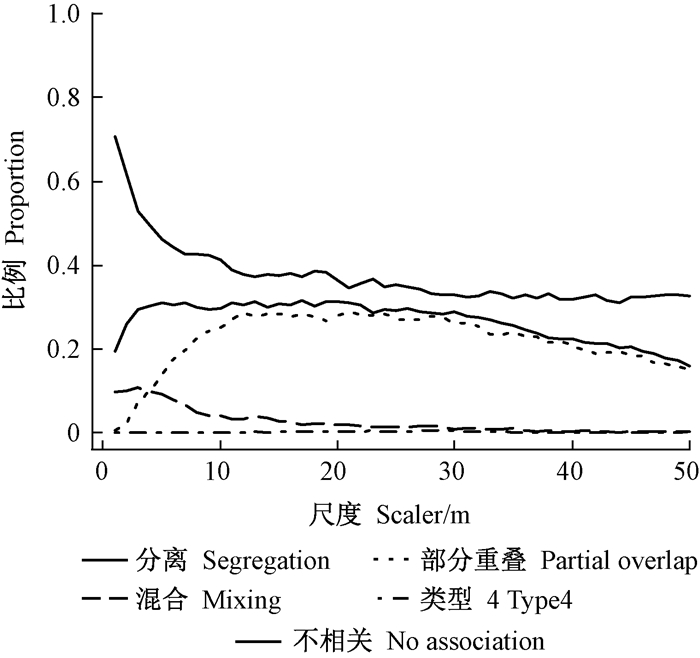
|
图 1 总体种间关联性类型所占比例随尺度的变化 Figure 1 Overall interspecific association patterns in dependence on the scaler |
运用单变量g(r)函数和异质性泊松(HP)零模型分析了28个物种小尺度(0~30 m)种群空间分布格局。为展示不同物种在不同尺度上表现出不同的空间格局类型,以白牛槭、胡桃楸、红松和千金榆为例作图 2。白牛槭在0~13 m尺度表现为显著聚集分布格局,在28~30 m尺度表现为显著的规则分布格局,而在14~27 m尺度表现为随机分布格局。红松仅在很小范围尺度内(0~7 m)表现为显著聚集格局,而在大部分尺度(8~30 m)则表现为随机分布格局;而千金榆则在很大范围尺度内(0~25 m)表现为聚集分布格局,仅在26~30 m尺度表现随机分布格局(图 2)。因此,不同物种在不同尺度上会表现出不同的空间格局类型。
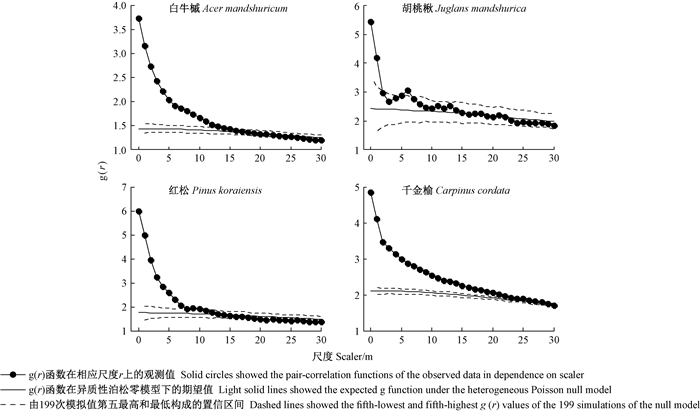
|
图 2 小尺度(0~30 m)种群空间分布格局示例 Figure 2 Examples for analyzing small scale (0-30 m) intraspecific patterns |
GOF适合度检验显示所有28个物种在0~30 m范围内均显著偏离零假设。为评价种群空间分布格局类型的尺度依赖效应,统计了不同尺度上表现不同格局类型的物种比例(仅统计适合度检验等级大于195的物种) (图 3)。8个(28.6%)物种表现出显著的聚集分布,20个物种在不同尺度上即表现出聚集分布又表现出规则分布;25个(89.3%)物种在0~4 m内表现为显著聚集格局,18个(64.3%)物种在5~10 m内表现为显著聚集;仅有2个(7.1%)物种在11~16 m表现为显著聚集;除千金榆,没有物种在15 m尺度以后表现出显著聚集格局。不同的格局类型在不同尺度上所占的比例存在差异性,表明不同格局类型存在强烈的尺度依赖效应。聚集分布格局在0~6 m内所占比例最高,其后随尺度增加呈直线下降,至15 m时,聚集分布格局消失,而均匀分布所占比例从13 m起随尺度增加而逐渐增加(图 3)。
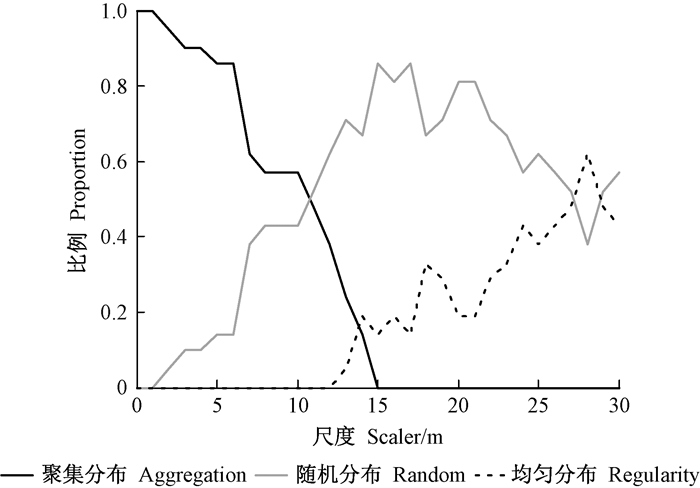
|
图 3 小尺度(0~30 m)种群空间分布格局各类型所占比例随尺度的变化 Figure 3 Small scale (0-30 m) univariate intraspecific patterns in dependence on scaler |
运用双变量g12(r)函数和异质性泊松零模型分析了全部物种对在小尺度内(0~30 m)的种间空间关联格局。由于色木槭-千金榆、千金榆-花楷槭(Acer ukurunduense)、白牛槭-毛榛(Corylus mandshurica)和红松-紫椴4个物种对的种间关联格局在0~30 m尺度上既表现有聚集分布,也有随机分布和规则分布,能较好展示不同物种之间在不同尺度上的空间关联格局类型,因此以该4个物种对的种间关联格局为例作图 4。结果表明,不同物种间以及同一物种对在不同尺度下种间关联类型存在差异。如白牛槭-毛榛在0~5 m尺度内表现为显著的相互排斥,其余尺度表现为种间无关联;千金榆-花楷槭以种间相互排斥为主(0~18 m);红松-紫椴在所有研究尺度内都表现出种间无关;色木槭-千金榆在0~14 m尺度内主要表现为种间相互吸引,15 m之后表现为种间无关(图 4)。
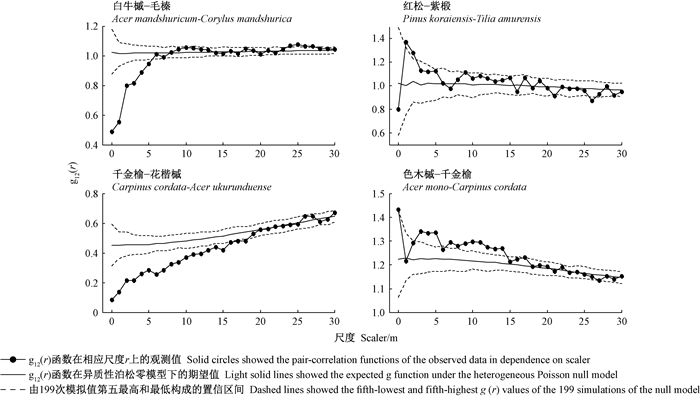
|
图 4 小尺度(0~30 m)种间空间关联格局示例 Figure 4 Examples for analyzing small scale (0-30 m) interspecific association patterns |
为评价种间关联格局的尺度依赖效应,统计0~30 m内每一尺度上种间关联格局类型所占的比例(仅统计适合度检验等级大于195的物种) (图 5)。多数尺度上,种间相互排斥所占比例高于种间相互吸引,种间相互排斥和相互吸引所占的比例分别在1和3 m尺度上达到最大,达到147和98个物种对,其后随尺度增加呈现降低趋势(图 5)。
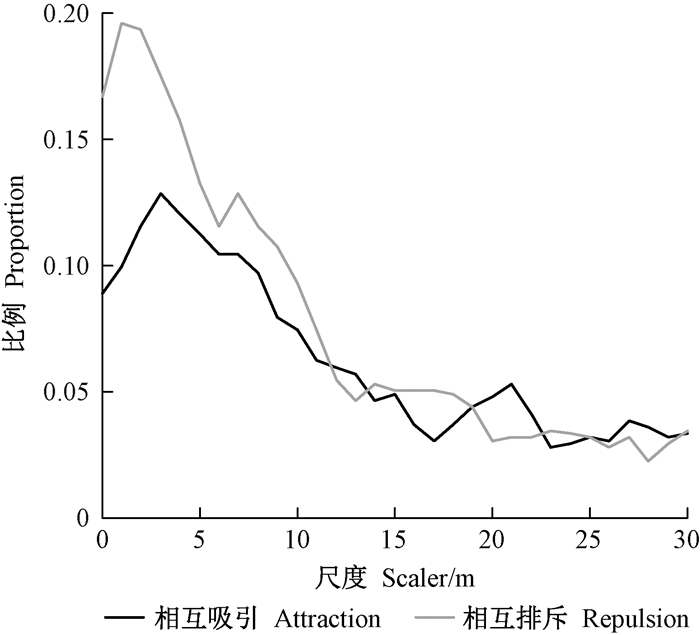
|
图 5 小尺度(0~30 m)双变量种间空间关联格局类型所占比例随尺度的变化 Figure 5 Small scale (0-30 m) bivariate interspecific association patterns in dependence on scaler |
本研究对吉林蛟河30 hm2阔叶红松林中28个物种所有DBH ≥ 1 cm个体的树种空间分布格局及其种间关联性进行了较为系统全面的分析,参与分析的物种总个体数占样地总个体数的99.4%,能够较全面地反映样地内个体的空间分布格局。
单变量g(r)函数及完全空间随机零模型(CSR)分析结果显示所有物种均表现出显著的空间聚集格局,表明总体空间分布格局的非随机性。这一结果与长白山地区温带阔叶红松林研究结果一致(Wang et al., 2010),表明多数物种的空间分布格局并非完全随机,而是在某些尺度上表现为聚集或分散。
单变量g(r)函数及异质性泊松模型分析结果表明本研究中检验的物种普遍在较小尺度上(0~10 m)表现为聚集分布格局,而在15 m以上尺度种群空间分布格局主要表现为随机分布和均匀分布(图 3),表明同种个体更易于聚集在紧邻同种个体的周围,即大多数物种表现为种内聚集,这可能是由种子扩散限制(He et al., 1997; Murrell et al., 2002)和生境异质性(Harms et al., 2001; Lai et al., 2009; Legendre et al., 2009)导致的。由于局部扩散方式导致大部分种子落在母株树下,而不能散布到离母树较远的位置,离母株越远,种子的数量越少。即使靠风力传播种子的物种,如色木槭、白牛槭等,其种群空间格局在15 m以内同样表现出显著的聚集格局(表 1);而胡桃楸、红松、蒙古栎、水榆花楸、瘤枝卫矛和翅卫矛等靠重力传播种子的物种,则在更小的空间范围内表现出显著的聚集格局(表 1)。其次,根据王雨茜(2013)研究结果,样地内所有个体总体径级分布为倒J型,其中DBH ≤ 5 cm的个体约占52.5%,胸径≤ 10 cm的个体约占73.3%,说明大多数个体处于生活史早期阶段,并未经历生境过滤和负密度制约效应长时间累积效应的影响(Bruelheide et al., 2011; Yao et al., 2016),因而可能是导致较大程度的种内聚集格局产生的一个原因;另一方面,成年树周围适宜种群生长的生境,有助于更新体的存活,也是导致同种个体在较小尺度上聚集的原因(Getzin et al., 2008)。而千金榆在较大尺度上(15~25 m)仍表现为显著的种内聚集格局,说明千金榆的分布与生境存在紧密关联。例如Zhang等(2012)在同一样地内研究发现千金榆具有极显著的生境偏好,其空间分布与地形凹凸度和坡向具有显著的关联性。
空间分离是物种共存的重要驱动因素之一(Pacala, 1997; Chesson, 2000),其作用机理是物种间的空间分离格局减少了不同物种之间相遇的几率,因此相对于种间竞争而言,种内之间的竞争占据主导,减少种间竞争能够阻止或减缓竞争优势物种对竞争劣势物种的竞争排除作用(Stoll et al., 2001),有利于维持物种共存,促进生物多样性。本研究中,完全空间随机零模型下总体空间格局分析结果显示,所有物种均表现出显著的种内聚集格局且大多数尺度上分离和部分重叠类型是主要的种间格局类型,表明不同物种个体之间在空间上更加趋向于分离,不同物种个体之间的相互关系表现为互相排斥,种间个体直接相互作用的机会少,表现为种内聚集和种间分离,因此本研究结果支持空间分离假说。
尽管针对温带森林群落空间格局分析已有大量研究,但大多研究仅对群落中少数优势树种空间关联格局进行分析,群落水平上的研究较为少见,通过研究种群空间分布格局与种间关联性进一步深入理解群落尺度上的物种共存与生物多样性维持机制的探讨相对缺乏。本研究对温带地区针阔混交林种群空间格局及种间空间关联格局在群落水平上进行了较为全面的探讨,未来还需针对其他地区森林群落(如热带森林、亚热带森林等)进行比较性研究,通过对不同地区研究结果的比较分析,进一步明确影响森林群落物种共存和促进生物多样性维持的普遍性机制。
5 结论本研究基于吉林蛟河阔叶红松林30 hm2动态监测样地数据,运用空间点格局分析方法,在群落水平上对28个物种不同尺度的种群空间分布格局及其种间关联性进行较为全面的分析研究,结果表明种内聚集和种间分离是该研究群落的主要空间构型,物种间的空间分离减弱种间竞争,阻止或减缓竞争优势物种对竞争劣势物种的竞争排除作用有利于维持物种共存,有利于该温带阔叶红松林物种多样性维持。
侯红亚, 王立海. 2013. 小兴安岭阔叶红松林物种组成及主要种群的空间分布格局[J]. 应用生态学报, 24(11): 3043-3049. (Hou H Y, Wang L H. 2013. Species composition and main populations spatial distribution pattern in Korean pine broad-leaved forest in Xiaoxing'an Mountains of Northeast China[J]. Chinese Journal of Applied Ecology, 24(11): 3043-3049. [in Chinese]) |
侯向阳, 韩进轩. 1997. 长白山红松林主要树种空间格局的模拟分析[J]. 植物生态学报, 21(3): 242-249. (Hou X Y, Han J X. 1997. Simulation analysis of spatial patterns of main species in the Korean Pine broadleaved forest in Changbai Mountain[J]. Chinese Journal of Plant Ecology, 21(3): 242-249. [in Chinese]) |
胡艳波, 惠刚盈, 戚继忠, 等. 2003. 吉林蛟河天然红松阔叶林的空间结构分析[J]. 林业科学研究, 16(5): 523-530. (Hu Y B, Hui G Y, Qi J Z, et al. 2003. Analysis of the spatial structure of natural Korean pine broadleaved forest[J]. Forest Research, 16(5): 523-530. [in Chinese]) |
惠刚盈. 2013. 基于相邻木关系的林分空间结构参数应用研究[J]. 北京林业大学学报, 35(4): 1-8. (Hui G Y. 2013. Studies on the application of stand spatial structure parameters based on the relationship of neighborhood trees[J]. Journal of Beijing Forestry University, 35(4): 1-8. [in Chinese]) |
惠刚盈. 1999. 角尺度——一个描述林木个体分布格局的结构参数[J]. 林业科学, 35(1): 37-42. (Hui G Y. 1999. The neighbourhood pattern—A new structure parameter for describing distribution of forest tree position[J]. Scientia Silvae Sinicae, 35(1): 37-42. [in Chinese]) |
李俊清. 1986. 阔叶红松林中红松的分布格局及其动态[J]. 东北林业大学学报, 14(1): 33-38. (Li J Q. 1986. Distribution pattern and dynamics of Pinus koraiensis in Korean pine broadleaved forests[J]. Journal of Northeast Forestry University, 14(1): 33-38. [in Chinese]) |
孙伟中, 赵士洞. 1997. 长白山北坡椴树阔叶红松林群落主要树种分布格局的研究[J]. 应用生态学报, 8(2): 119-122. (Sun W Z, Zhao S D. 1997. Distribution patterns of main tree species in Tilia broadleaf Korean pine forest on northern slope of Changbai Mountains[J]. Chinese Journal of Applied Ecology, 8(2): 119-122. [in Chinese]) |
王蕾, 张春雨, 赵秀海. 2009. 长白山阔叶红松林的空间分布格局[J]. 林业科学, 45(5): 54-59. (Wang L, Zhang C Y, Zhao X H. 2009. Spatial pattern of Korean pine broadleaved forests in Changbai Mountains[J]. Scientia Silvae Sinicae, 45(5): 54-59. DOI:10.11707/j.1001-7488.20090508 [in Chinese]) |
王雨茜. 2013. 吉林蛟河老龄林群落特征及其与地形关系. 北京: 北京林业大学博士学位论文. (Wang Y X. 2013. The community structure characteristics and the relation between the characteristics and terrain features of the old-growth forest in Jiaohe Jilin Province. Beijing: PhD thesis of Beijing Forestry University. [in Chinese]) |
徐海, 惠刚盈, 胡艳波, 等. 2006. 天然红松阔叶林不同径阶林木的空间分布特征分析[J]. 林业科学研究, 19(6): 687-691. (Xu H, Hui G Y, Hu Y B, et al. 2006. Analysis of spatial distribution characteristics of trees with different diameter classes in natural Korean pine broadleaved forest[J]. Forest Research, 19(6): 687-691. [in Chinese]) |
阳含熙. 1985. 长白山北坡红松阔叶林主要树种的分布格局[J]. 森林生态系统研究, (5): 1-14. (Yang H X. 1985. The distribution pattern of main species of Korean pine broad-leaved forests on northern slope of Changbai Mountains[J]. Forest Ecosystem Research, (5): 1-14. [in Chinese]) |
祝燕, 白帆, 刘海丰, 等. 2011. 北京暖温带次生林种群分布格局与种间空间关联性[J]. 生物多样性, 19(2): 252-259. (Zhu Y, Bai F, Liu H F, et al. 2011. Population distribution patterns and interspecific spatial associations in warm temperate secondary forests, Beijing[J]. Biodiversity Science, 19(2): 252-259. [in Chinese]) |
Brown J H, Mehlman D H, Stevens G C. 1995. Spatial variation in abundance[J]. Ecology, 76(7): 2028-2043. DOI:10.2307/1941678 |
Bruelheide H, Böhnke M, Both S, et al. 2011. Community assembly during secondary forest succession in a Chinese subtropical forest[J]. Ecological Monographs, 81(1): 25-41. DOI:10.1890/09-2172.1 |
Bruno J F, Stachowicz J J, Bertness M D. 2003. Inclusion of facilitation into ecological theory[J]. Trends in Ecology & Evolution, 18(3): 119-125. |
Callaway R M, Walker L R. 1997. Competition and facilitation:a synthetic approach to interactions in plant communities[J]. Ecology, 78(7): 1958-1965. DOI:10.1890/0012-9658(1997)078[1958:CAFASA]2.0.CO;2 |
Chesson P. 2000. Mechanisms of maintenance of species diversity[J]. Annual Review of Ecology and Systematics, 31(1): 343-366. DOI:10.1146/annurev.ecolsys.31.1.343 |
Condit R, Ashton P S, Baker P, et al. 2000. Spatial patterns in the distribution of tropical tree species[J]. Science, 288(5470): 1414-1418. DOI:10.1126/science.288.5470.1414 |
Connell J H. 1971. On the roles of natural enemies in preventing competitive exclusion in some marine animals and in rain forest trees//den Boer P J, Gradwell G R. Dynamics of numbers in populations. Wageningen, Netherlands: Centre for Agricultural Publishing and Documentation, 298-312.
|
Diggle P J. 2003. Statistical analysis of spatial point patterns[M]. 2nd ed. London: Arnold.
|
Getzin S, Wiegand T, Wiegand K, et al. 2008. Heterogeneity influences spatial patterns and demographics in forest stands[J]. Journal of Ecology, 96(4): 807-820. DOI:10.1111/jec.2008.96.issue-4 |
Gunatilleke C V S, Gunatilleke I A U N, Esufali S, et al. 2006. Species-habitat associations in a Sri Lankan dipterocarp forest[J]. Journal of Tropical Ecology, 22(4): 371-384. DOI:10.1017/S0266467406003282 |
Harms K E, Condit R, Hubbell S P, et al. 2001. Habitat associations of trees and shrubs in a 50-ha neotropical forest plot[J]. Journal of Ecology, 89(6): 947-959. DOI:10.1111/jec.2001.89.issue-6 |
He F L, Legendre P, LaFrankie J V. 1997. Distribution patterns of tree species in a Malaysian tropical rain forest[J]. Journal of Vegetation Science, 8(1): 105-114. DOI:10.2307/3237248 |
Hubbell S P. 1997. A unified theory of biogeography and relative species abundance and its application to tropical rain forests and coral reefs[J]. Coral Reefs, 16(Suppl 1): S9-S21. |
Hubbell S P. 2001. The unified neutral theory of biodiversity and biogeography[M]. Princeton, NJ: Princeton University Press.
|
Illian J, Penttinen A, Stoyan H, et al. 2008. Statistical analysis and modelling of spatial point patterns[M]. Chichester: John Wiley and Sons.
|
Janzen D H. 1970. Herbivores and the number of tree species in tropical forests[J]. The American Naturalist, 104(940): 501-528. DOI:10.1086/282687 |
Lai J S, Mi X C, Ren H B, et al. 2009. Species-habitat associations change in a subtropical forest of China[J]. Journal of Vegetation Science, 20(3): 415-423. DOI:10.1111/jvs.2009.20.issue-3 |
Legendre P, Mi X C, Ren H B, et al. 2009. Partitioning beta diversity in a subtropical broad-leaved forest of China[J]. Ecology, 90(3): 663-674. DOI:10.1890/07-1880.1 |
Levin S A. 1992. The problem of pattern and scale in ecology:the Robert H[J]. MacArthur award lecture. Ecology, 73(6): 1943-1967. |
Loosmore N B, Ford E D. 2006. Statistical inference using the G or K point pattern spatial statistics[J]. Ecology, 87(8): 1925-1931. DOI:10.1890/0012-9658(2006)87[1925:SIUTGO]2.0.CO;2 |
Lortie C J, Brooker R W, Choler P, et al. 2004. Rethinking plant community theory[J]. Oikos, 107(2): 433-438. DOI:10.1111/oik.2004.107.issue-2 |
Luo Z R, Yu M J, Chen D L, et al. 2012. Spatial associations of tree species in a subtropical evergreen broad-leaved forest[J]. Journal of Plant Ecology, 5(3): 346-355. DOI:10.1093/jpe/rtr048 |
Murrell D, Purves D, Law R. 2002. Intraspecific aggregation and species coexistence[J]. Trends in Ecology & Evolution, 17(5): 210-211. |
Pacala S W. 1997. Dynamics of plant communities(2nd edn). Oxford, UK: Blackwell Publishing Ltd, 532-555.
|
Ricklefs R E. 1990. Ecology(3rd edn). New York: W H Freeman and Company.
|
Ripley B D. 1981. Spatial Statistics. New York: Wiley.
|
Stoll P, Prati D. 2001. Intraspecific aggregation alters competitive interactions in experimental plant communities[J]. Ecology, 82(2): 319-327. DOI:10.1890/0012-9658(2001)082[0319:IAACII]2.0.CO;2 |
Stoyan D, Stoyan H. 1994. Fractals, random shapes and point fields. New York: Wiley.
|
Wang X G, Wiegand T, Hao Z Q, et al. 2010. Species associations in an old-growth temperate forest in north-eastern China[J]. Journal of Ecology, 98(3): 674-686. DOI:10.1111/jec.2010.98.issue-3 |
Wiegand T, Gunatilleke S, Gunatilleke N. 2007a. Species associations in a heterogeneous Sri Lankan Dipterocarp forest[J]. The American Naturalist, 170(4): E77-E95. DOI:10.1086/521240 |
Wiegand T, Gunatilleke S, Gunatilleke N, et al. 2007b. Analyzing the spatial structure of a Sri Lankan tree species with multiple scales of clustering[J]. Ecology, 88(12): 3088-3102. DOI:10.1890/06-1350.1 |
Wiegand T, Gunatilleke C V S, Gunatilleke I A U N, et al. 2007c. How individual species structure diversity in tropical forests[J]. Proceedings of the National Academy of Sciences, 104(48): 19029-19033. DOI:10.1073/pnas.0705621104 |
Wiegand T, Moloney K A. 2014. Handbook of spatial point-pattern analysis in Ecology[M]. New York: CRC Press.
|
Wiegand T, Moloney K A. 2004. Rings, circles, and null-models for point pattern analysis in ecology[J]. Oikos, 104(2): 209-229. DOI:10.1111/oik.2004.104.issue-2 |
Wong Y K, Whitmore T C. 1970. On the influence of soil properties on species distribution in a Malayan lowland dipterocarp forest[J]. Malayan Forester, 33(1): 42-54. |
Yao J, Zhang X N, Zhang C Y, et al. 2016. Effects of density dependence in a temperate forest in northeastern China[J]. Scientific Reports, 6: 32844. DOI:10.1038/srep32844 |
Zhang C Y, Zhao Y Z, Zhao X H, et al. 2012. Species-habitat associations in a northern temperate forest in China[J]. Silva Fennica, 46(4): 501-519. |
Zhu Y, Mi X C, Ren H B, et al. 2010. Density dependence is prevalent in a heterogeneous subtropical forest[J]. Oikos, 119(1): 109-119. DOI:10.1111/oik.2010.119.issue-1 |
 2018, Vol. 54
2018, Vol. 54

